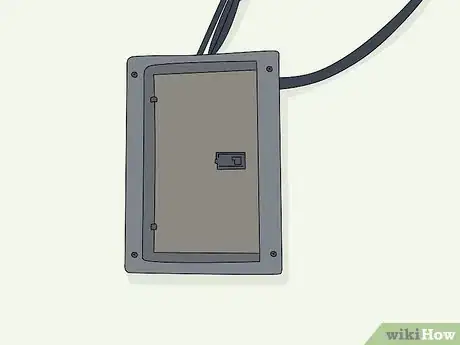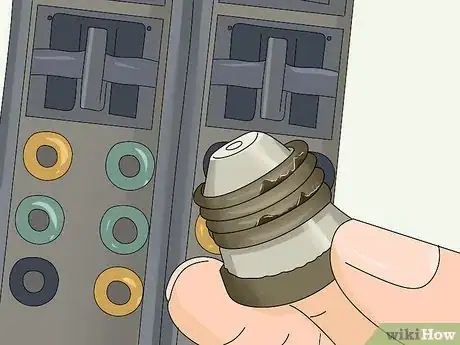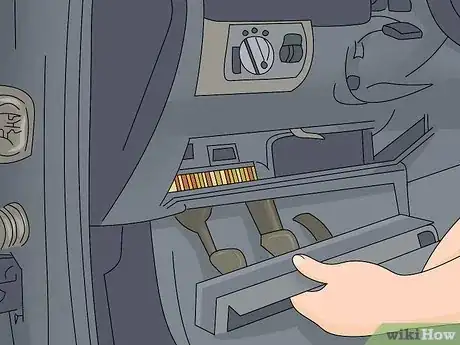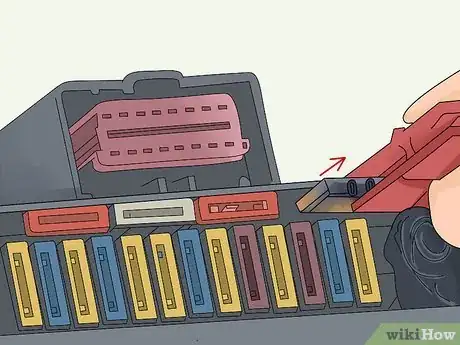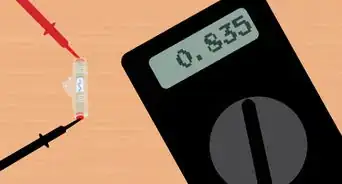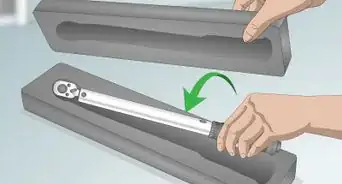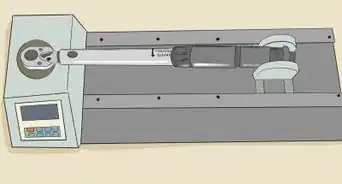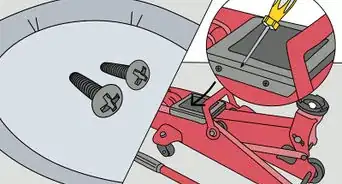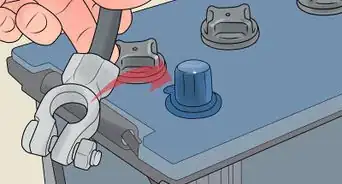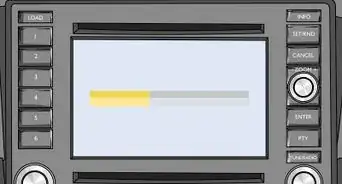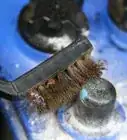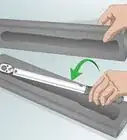This article was co-authored by Ralph Childers. Ralph Childers is a master electrician based in the Portland, Oregon area with over 30 years of conducting and teaching electrical work. Ralph received his B.S. in Electrical Engineering from the University of Louisiana at Lafayette and holds an Oregon Journeyman Electrical License as well as electrician licenses in Louisiana and Texas.
There are 8 references cited in this article, which can be found at the bottom of the page.
This article has been viewed 651,987 times.
A blown fuse can be annoying, but it actually helps prevent electrical damage and fire. Fortunately, fuses are inexpensive and easy to replace. If the power’s out in your home or car, you should be able to check the fuses simply by looking at them. Look inside the fuse in question for black charred marks or a broken filament wire. If you can’t see any obvious signs, you can always use a test light or multimeter to figure out if the fuse is working properly.
Steps
Checking Your Home’s Fuse Box
-
1Look for the fuse box in your basement or garage. Check for a metal box with a door; inside you’ll see lots of glass fuses that screw into sockets. Typically, fuse boxes are located in basements, garages, laundry rooms, and attics.[1]
- If you have trouble finding your fuse box, check the utility meter outside your home. Try to follow the wire that leads from the meter. Fuse boxes and circuit breakers are usually located near where power enters the house.
- Older homes have glass fuses that look like light bulbs. When fuses blow, they need to be replaced. Newer homes, on the other hand, have circuit breakers instead, which just need to be flipped and reset.
-
2Turn off the power and unplug the appliances on the blown circuit. Look for a large switch at the top of the panel and toggle it from “On” to “Off.” In addition to shutting off the main power, unplug the appliances that turned off when the fuse blew. That way, they won’t overload the replacement fuse when you turn on main power.[2]
- If there’s no main power switch, you should see a large block at the top of the panel. Pull it out and check for “On” and “Off labels. If it’s labeled, reinsert it with the “Off” side facing up. If there’s no label, set the block aside while you replace the blown fuse.
Advertisement -
3Check the fuses for charred glass or broken filaments. See if there’s a diagram or labels on the inside of the panel door. If you’re lucky, you’ll be able to look up the room where the power went out and track down the corresponding fuse. Twist that fuse counterclockwise, pull it out from the socket, and look inside the glass for black marks or a broken filament wire.[3]
- If your fuse box is unlabeled, check each fuse individually for charred marks or broken filaments. Once you’ve found the one that blew, label it! If you label your fuses every time you replace one, you’ll eventually have a full diagram of the box.
-
4Swap the blown fuse out for one with the same power rating. Look for a number on the fuse, which indicates its amp rating. Write down the number or take the blown fuse with you to the hardware store to ensure you get an identical match. Then, plug the replacement fuse in and turn it clockwise to lock it in place.[4]
- Fuse ratings vary by country, but common amperages include 15, 20, and 30.
Safety Warning: Never use a fuse with a higher amperage than the one that blew. Installing the wrong fuse can cause electrical damage or a fire.
-
5Turn the power back on to test the new fuse. Once you've plugged in the fuse, double-check to make sure you disconnected all of your electrical devices from the broken circuit. When you’re ready, flip the main fuse switch or reinsert the main block to restore power to your home. Then test the circuit by checking the lights or plugging in your electronic devices.[5]
- If your electronics still don’t work after replacing the fuse, shut down main power and make sure the fuse is tightly connected.
- If the fuse blows again soon after you replaced it, you may be using more electrical devices than the circuit can handle. Try using fewer devices or unplug non-essential appliances when they’re not in use.[6]
- If you still can’t find the problem, call an experienced electrician. It could mean that your home’s wiring is faulty.
Troubleshooting Your Car’s Fuses
-
1Look under the hood or dashboard for your vehicle’s fuse box. Many cars have 2 or more fuse boxes, but there's no universal standard for their placement. Most manufacturers place them near the car’s engine or battery, beneath the steering wheel, or inside the glove box. Look for a gray or black box; it may be labeled as “Fuses.”[7]
- Check your car’s manual if you have trouble finding the fuse boxes. If you don’t have your manual, search online for “fuse box placement” plus your car’s year, make, and model.
-
2Find the fuse that controls the device that’s stopped working. Lift the latch on the side of the fuse box to loosen the cover. Check the inside of the lid for a diagram of the devices each fuse controls. Your manual may also include a diagram but, if all else fails, you can also find information on your specific vehicle online.[8]
- The diagram will also list the fuse’s amperage, which you’ll need to know to purchase a replacement.
- Be sure to turn your car off before troubleshooting the fuse box.
-
3Remove the blown fuse from the box using fuse pullers or tweezers. Some cars and fuse replacement kits include small plastic fuse pullers, which you can use to pluck the fuse from the box. If you don’t have fuse pullers handy, a pair of tweezers will do the trick. In a pinch, you can also carefully pull the fuse from the box with your fingers.[9]
- Make sure your car is completely off before you pull out the blown fuse. Keep the keys out of the ignition to avoid accidentally putting it in “Run” or “Accessories” mode. Otherwise, you could get a nasty shock.
-
4Check the fuse for a broken filament or discoloration. Car fuses are small, so it’s a little tougher to find signs that one blew. Hold it up to the light and look closely inside for a thin wire that connects the 2 sides of the fuse. If the wire is broken, or if you see charred marks, the fuse has blown.[10]
- If the wire is intact and the fuse seems fine, double-check your diagram to ensure you have the correct fuse. If you've checked each fuse individually and none have blown, your car’s electrical system may need a mechanic’s attention.
- If you’re not able to visually tell if the fuse has blown, then you may need to check the fuses with a multimeter to determine if it’s working.
-
5Install a new fuse with an amperage that matches the one that blew. Head to an auto shop or major retailer's automotive department to find fuses for your car. Bring the blown fuse with you to ensure you get the right match. Once you’ve purchased the right replacement, simply insert it into the slot where you removed the blown fuse.[11]
- Make sure the car is off before you set the fuse into the empty slot. Press down with a little pressure until it pops into place.
- Car fuses are color-coded, so if the fuses are a different color, you know right away they aren’t a match. Additionally, be sure the prong shape of the new fuse matches the old one. If necessary, ask an employee at the store for help finding the right replacement.
Tip: If your car is disabled due to a blown fuse, you could swap out a matching fuse that controls a non-essential device. For instance, if the fuse that controls your ignition blew, you could temporarily use the one for your radio, as long as the 2 fuses are identical.[12]
Using Fuse Testing Devices
-
1Check automotive fuses with a simple test light. Put your key in the ignition and turn it to accessories mode. Open the fuse box, then insert the tester’s probe into the tiny port on the face of a fuse. If the tester lights up, the fuse is working properly.[13]
- Using a test light is a great way to find a blown fuse when you can’t identify visual signs, such as a broken filament or black marks.
- You can find car fuse test lights online, at auto shops, and in the automotive department at most major retailers. The tester has 1 or 2 prongs that fit into the tiny test ports on the outside face of all automotive fuses.
Tip: There’s no need to turn on the car’s engine, but be sure to test your car’s fuses in accessories mode. Otherwise, there won’t be an electrical current flowing to the fuses. Just remember to turn off the car before removing a fuse.
-
2Test a plug fuse with a multimeter if you don’t see signs that it blew. Set your multimeter to test resistance; the setting looks like the Greek letter omega, or “Ω.” Turn off the fuse box’s main power switch, then remove the fuse you’d like to test. Set the fuse glass-side-down on a non-conductive surface, such as a wood workbench or laminate counter, so the metal plug end faces up.[14]
- Plug fuses, which are often found in home fuse boxes, have threaded terminals that look like the ends of standard light bulbs. To test it, touch one of the multimeter’s probes to the very tip of the fuse’s terminal. Touch the other probe to the side of the terminal near where the threading stops.
- If the multimeter displays a resistance between 0 and 5 Ω (ohms), the fuse is good. A higher resistance means a degraded or potentially blown fuse, and a reading of OL (over limit) means the fuse is definitely blown.[15]
- Like an automotive test light, using a multimeter to test a home plug fuse is a good solution if you suspect a blown fuse but can’t find any clear visual signs.
-
3Use a multimeter to test cylindrical fuses in electronic devices. If your electronic instrument or appliance is on the fritz, remove the fuse according to the manufacturer’s instructions. Typically, electronic devices use tube-shaped fuses with a glass body and terminals at each end. Set your multimeter to test resistance, and place the fuse on a non-conductive surface.[16]
- Touch one of the multimeter’s probes to each of the fuse’s terminals. As with plug fuses, a resistance reading of 0 to 5 Ω means the fuse works. A higher reading or a reading of OL means the fuse is bad.
- You can inspect cylindrical fuses for broken filaments or charred marks just like automotive and plug fuses. However, if you can’t see clearly inside the fuse, testing it with a multimeter can help you figure out whether or not it works.
Warnings
- To avoid electrical shock, always turn off the electricity before touching any fuses.⧼thumbs_response⧽
References
- ↑ https://www.familyhandyman.com/electrical/wiring-outlets/troubleshooting-dead-outlets/
- ↑ https://worksafe.govt.nz/managing-health-and-safety/consumers/safe-living-with-electricity/electrical-wiring-in-your-home/
- ↑ https://www.familyhandyman.com/electrical/wiring-outlets/troubleshooting-dead-outlets/
- ↑ https://worksafe.govt.nz/managing-health-and-safety/consumers/safe-living-with-electricity/electrical-wiring-in-your-home/
- ↑ https://www.familyhandyman.com/electrical/wiring-outlets/troubleshooting-dead-outlets/
- ↑ https://www.bbc.com/bitesize/guides/z886b82/revision/2
- ↑ https://www.dmv.org/how-to-guides/fuse.php
- ↑ https://www.familyhandyman.com/automotive/car-maintenance/replacing-auto-fuses/
- ↑ https://www.dmv.org/how-to-guides/fuse.php
- ↑ https://www.familyhandyman.com/automotive/car-maintenance/replacing-auto-fuses/
- ↑ https://www.familyhandyman.com/automotive/car-maintenance/replacing-auto-fuses/view-all/
- ↑ https://www.dmv.org/how-to-guides/fuse.php
- ↑ https://www.familyhandyman.com/automotive/car-maintenance/replacing-auto-fuses/
- ↑ http://www.learningaboutelectronics.com/Articles/How-to-test-a-fuse
- ↑ https://www.ncbi.nlm.nih.gov/pmc/articles/PMC3483613/
- ↑ https://www.ncbi.nlm.nih.gov/pmc/articles/PMC3483613/
About This Article
To check fuses in your home fuse box, first find the fuse box, which may be located in your garage, basement, utility room, or attic. Once you find the fuse box, shut off the power at the main switch. To avoid overloading the replacement fuse, also unplug any appliances that turned off when the fuse blew. After the power is off, locate the fuse that corresponds to the room where the power went out and twist it out of its socket. Check if the fuse is broken by looking inside the glass for black char marks or a broken filament wire. When you’ve identified the blown fuse, replace it with a new one that has the same power rating, then turn the power back on to test it. To learn how to check fuses in a car, read on!
